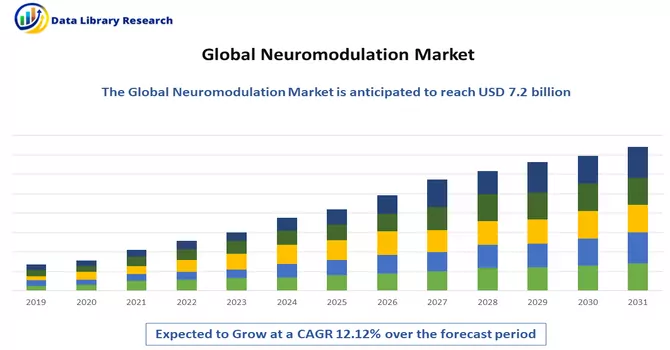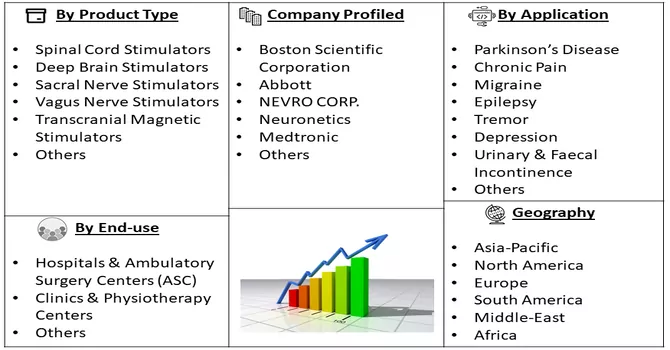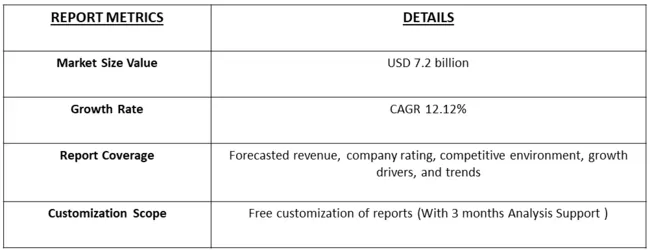The Neuromodulation Market is expected to reach USD 7.2 billion in 2023 and grow at a CAGR of 12.12% during the forecast period, 2024-2031.

Get Complete Analysis Of The Report - Download Free Sample PDF
The Neuromodulation market is characterized by a dynamic landscape at the intersection of medical technology and neuroscience, offering innovative solutions for managing various chronic conditions. Neuromodulation involves the targeted stimulation or modulation of the nervous system to alleviate symptoms associated with neurological disorders and chronic pain. Key modalities within this market include spinal cord stimulation, deep brain stimulation, and sacral nerve stimulation. The market is fueled by the increasing prevalence of neurological disorders, such as epilepsy, Parkinson's disease, and chronic pain conditions, driving the demand for effective and minimally invasive therapeutic interventions. Advancements in technology, including more sophisticated devices and improved stimulation techniques, contribute to the market's growth. Furthermore, a growing emphasis on patient-centric approaches, coupled with expanding applications across different medical specialties, positions neuromodulation as a transformative field with the potential to enhance the quality of life for individuals grappling with neurological conditions. The neuromodulation market is poised for continued expansion as research, innovation, and clinical applications evolve, offering novel avenues for addressing complex neurological challenges.
The growth of the neuromodulation market is driven by several factors, including the increasing prevalence of neurological disorders such as chronic pain, epilepsy, and Parkinson's disease. The rising ageing population, coupled with a higher incidence of these disorders among the elderly, is further propelling market growth. Additionally, advancements in neuromodulation technologies, such as the development of minimally invasive procedures and innovative devices, are expanding treatment options and improving patient outcomes. Moreover, growing awareness about the benefits of neuromodulation therapies among patients and healthcare providers, along with favorable reimbursement policies, are contributing to market expansion. Furthermore, the ongoing research and development activities aimed at expanding the applications of neuromodulation in treating various neurological conditions are expected to drive further growth in the market.
Market segmentation: The Neuromodulation Devices Market is Segmented by Technology (Internal Neuromodulation (Spinal Cord Stimulation, Deep Brain Stimulation, Vagus Nerve Stimulation, Sacral Nerve Stimulation, Gastric Electrical Stimulation) and External Neuromodulation (Transcutaneous Electrical Nerve Stimulation, Transcranial Magnetic Stimulation, and Others)), Application (Parkinson's Disease, Epilepsy, Depression, Dystonia, Pain Management, and Other Applications), and Geography (North America, Europe, Asia-Pacific, Middle East and Africa, and South America). The report offers the value (in USD) for the above segments.

For Detailed Market Segmentation - Download Free Sample PDF
The market trends in neuromodulation reflect a dynamic landscape driven by technological advancements, expanding clinical applications, and a growing emphasis on personalized and patient-centric therapies. Recent years have witnessed a surge in the development of more sophisticated neuromodulation devices, offering enhanced precision and therapeutic outcomes. There is a notable trend towards the integration of artificial intelligence and machine learning algorithms, optimizing treatment algorithms and personalizing therapy delivery. Moreover, neuromodulation is expanding beyond traditional applications, with emerging therapies targeting psychiatric disorders, such as depression and obsessive-compulsive disorder. The market also sees increased collaboration between industry players and research institutions, fostering innovation and the exploration of novel neuromodulation modalities. As awareness grows and the evidence base strengthens, the neuromodulation market is evolving towards more tailored and effective interventions, promising significant advancements in the management of neurological conditions and chronic pain.
Market Drivers:
The rising incidence of neurological conditions such as chronic pain, epilepsy
The escalating incidence of neurological conditions, notably chronic pain and epilepsy, serves as a prominent driver in shaping the landscape of the neuromodulation market. With an aging global population and a surge in chronic health conditions, there has been a substantial increase in individuals grappling with debilitating neurological disorders. Chronic pain, affecting millions worldwide, presents a particularly challenging and widespread health concern, necessitating innovative solutions for effective management. Simultaneously, the rising prevalence of epilepsy, a neurological disorder characterized by recurrent seizures, further underscores the urgency for advanced therapeutic interventions. Neuromodulation emerges as a crucial and evolving approach to addressing these conditions, offering patients a means to alleviate symptoms and enhance their overall well-being. As awareness grows and the burden of neurological disorders persists, the neuromodulation market is propelled by the imperative to meet the escalating demand for targeted and personalized treatments that can provide meaningful relief for those affected by chronic pain and epilepsy.
Ongoing technological innovations in neuromodulation devices
Ongoing technological innovations in neuromodulation devices represent a pivotal driver in advancing the field and transforming the landscape of neurological care. Continuous developments in device engineering, materials, and stimulation technologies contribute to enhanced precision, efficacy, and patient outcomes. Miniaturization of devices allows for less invasive implantation procedures, reducing patient discomfort and recovery times. Connectivity features enable real-time monitoring and adjustments, fostering personalized treatment plans. Moreover, advancements in stimulation techniques, such as closed-loop systems and adaptive algorithms, optimize therapeutic outcomes by tailoring neuromodulation to individual patient responses. As technology continues to evolve, the neuromodulation market experiences a paradigm shift towards more sophisticated, patient-centric devices, offering novel and effective solutions for an expanding array of neurological conditions. These innovations underscore the dynamic nature of the neuromodulation market, positioning it at the forefront of cutting-edge medical technologies.
Market Restraints:
Several market restraints present challenges to the neuromodulation market, with one significant factor being the high cost associated with neuromodulation devices and procedures. The expenses related to device development, manufacturing, and implantation can be substantial, limiting widespread adoption and accessibility. Additionally, reimbursement challenges and healthcare budget constraints pose barriers to patient access to neuromodulation therapies. The invasive nature of some neuromodulation procedures and the potential for adverse effects or complications, though infrequent, may contribute to hesitancy among both healthcare providers and patients. Furthermore, the regulatory landscape can be demanding, with stringent approval processes and evolving standards, leading to delays in bringing new devices to market. The variability in patient responses to neuromodulation therapies and the need for long-term maintenance and adjustments also pose challenges in achieving consistent and predictable outcomes. These multifaceted restraints collectively shape the intricate landscape of the neuromodulation market, emphasizing the necessity for addressing these challenges to unlock the full potential of neuromodulation technologies in neurological care.
The COVID-19 pandemic has exerted a complex impact on the neuromodulation market, influencing both patient access and industry dynamics. The surge in healthcare priorities towards pandemic management led to disruptions in elective medical procedures, including some neuromodulation interventions, impacting the treatment trajectory for patients. Supply chain disruptions and logistical challenges affected the manufacturing and distribution of neuromodulation devices. Moreover, the economic fallout of the pandemic has strained healthcare budgets, potentially limiting the adoption of costly neuromodulation therapies. On the other hand, the increased focus on telehealth and remote patient monitoring during the pandemic has spurred innovation in virtual care solutions for neuromodulation patients. While challenges persist, the neuromodulation market is adapting to the evolving healthcare landscape, emphasizing resilience, flexibility, and the potential for accelerated adoption of digital health solutions in neurological care.
Segmental Analysis:
Vagus Nerve Stimulation Segment is Expected to Witness Significant Growth Over the Forecast Period
Vagus nerve stimulation (VNS) devices are emerging as a key technology in the treatment of various neurological disorders, driving growth in the healthcare market. These devices deliver electrical impulses to the vagus nerve, which has been shown to help reduce the frequency and severity of seizures in epilepsy patients and alleviate symptoms of depression and other mood disorders. The market for VNS devices is expanding rapidly due to the increasing prevalence of epilepsy and depression, as well as the growing acceptance of neuromodulation therapies among patients and healthcare providers. Additionally, advancements in VNS technology, such as smaller and more efficient devices, are making treatment more accessible and effective. As a result, VNS devices are becoming an important tool in the management of neurological conditions, with significant potential for further growth and development in the future.
Depression Segment is Expected to Witness Significant Growth Over the Forecast Period
Depression is a widespread and debilitating mental health condition affecting millions worldwide, with a significant portion of patients experiencing limited relief from traditional treatments like medication and therapy. Neuromodulation devices, such as transcranial magnetic stimulation (TMS) and vagus nerve stimulation (VNS), offer promising alternatives for treatment-resistant depression. TMS uses magnetic fields to stimulate nerve cells in the brain regions associated with mood regulation, while VNS delivers electrical pulses to the vagus nerve, which then stimulates areas of the brain involved in mood control. These devices have shown effectiveness in reducing symptoms and improving mood in patients with depression, particularly those who have not responded well to other treatments. The market for neuromodulation devices for depression is expanding as more clinicians and patients seek non-invasive and potentially more effective options for managing this challenging condition. Ongoing research and technological advancements in neuromodulation hold promise for further improving outcomes and expanding treatment options for depression.
North America Region is Expected to Witness Significant Growth Over the Forecast Period
North America is a key region driving the growth of the neuromodulation devices market, fueled by several factors. The region has a high prevalence of neurological disorders, such as chronic pain, epilepsy, and Parkinson's disease, driving the demand for neuromodulation therapies. Additionally, the region has a well-established healthcare infrastructure and reimbursement framework, making it conducive for the adoption of neuromodulation devices. Furthermore, technological advancements in neuromodulation, including the development of minimally invasive procedures and innovative devices, are driving market growth in North America. The presence of major players in the region, along with strong research and development activities, further contribute to the growth of the neuromodulation devices market in North America. Overall, North America is a significant market for neuromodulation devices, with continued growth expected in the coming years. Thus, the region is expected to witness significant growth over the forecast period.

Get Complete Analysis Of The Report - Download Free Sample PDF
The analyzed market exhibits a high degree of fragmentation, primarily attributable to the presence of numerous players operating on both a global and regional scale. The competitive landscape is characterized by a diverse array of companies, each contributing to the overall market dynamics. This fragmentation arises from the existence of specialized solution providers, established industry players, and emerging entrants, all vying for market share. The diversity in market participants is underscored by the adoption of various strategies aimed at expanding the company presence. On a global scale, companies within the studied market are strategically positioning themselves through aggressive expansion initiatives. This often involves entering new geographical regions, targeting untapped markets, and establishing a robust global footprint. The pursuit of global expansion is driven by the recognition of diverse market opportunities and the desire to capitalize on emerging trends and demands across different regions. Simultaneously, at the regional level, companies are tailoring their approaches to align with local market dynamics. Regional players are leveraging their understanding of specific market nuances, regulatory environments, and consumer preferences to gain a competitive edge. This regional focus allows companies to cater to the unique needs of local clientele, fostering stronger market penetration. To navigate the complexities of the fragmented market, companies are implementing a range of strategies. These strategies include investments in research and development to stay at the forefront of technological advancements, mergers and acquisitions to consolidate market share, strategic partnerships for synergies, and innovation to differentiate products and services. The adoption of such multifaceted strategies reflects the competitive nature of the market, with participants continually seeking avenues for growth and sustainability. In essence, the high fragmentation in the studied market not only signifies the diversity of players but also underscores the dynamism and competitiveness that drive ongoing strategic maneuvers. As companies explore various avenues for expansion, the market continues to evolve, presenting both challenges and opportunities for industry stakeholders.
Some of the key market players working in this market are:
Recent Development:
1) In December 2022, Abbott Laboratories achieved a milestone with the FDA approval of its Eterna spinal cord stimulation (SCS) system. Distinguished as the smallest implantable and rechargeable spinal cord stimulator in the market, this breakthrough device is designed for the treatment of chronic pain. The Eterna SCS system utilizes Abbott's proprietary low-dose BurstDR stimulation, providing an innovative solution for individuals seeking relief from chronic pain.
2) In September 2023, PathMaker Neurosystems Inc. commenced a human clinical trial for its MyoRegulator device, a novel intervention intended for the treatment of amyotrophic lateral sclerosis (ALS). These developments underscore the continuous evolution and diversification within the field of neuromodulation, with each innovation addressing distinct clinical needs and pushing the boundaries of therapeutic possibilities.
Q1. What was the Neuromodulation Market size in 2023?
As per Data Library Research the Neuromodulation Market is expected to reach USD 7.2 billion in 2023.
Q2. At what CAGR is the Neuromodulation market projected to grow within the forecast period?
Neuromodulation Market is expected grow at a CAGR of 12.12% during the forecast period.
Q3. What are the Growth Drivers of the Neuromodulation Market?
The rising incidence of neurological conditions such as chronic pain, epilepsy and Ongoing technological innovations in neuromodulation devices are the Growth Drivers of the Neuromodulation Market.
Q4. Which Region is expected to hold the highest Market share?
North America region is expected to hold the highest Market share.
Data Library Research are conducted by industry experts who offer insight on industry structure, market segmentations technology assessment and competitive landscape (CL), and penetration, as well as on emerging trends. Their analysis is based on primary interviews (~ 80%) and secondary research (~ 20%) as well as years of professional expertise in their respective industries. Adding to this, by analysing historical trends and current market positions, our analysts predict where the market will be headed for the next five years. Furthermore, the varying trends of segment & categories geographically presented are also studied and the estimated based on the primary & secondary research.
In this particular report from the supply side Data Library Research has conducted primary surveys (interviews) with the key level executives (VP, CEO’s, Marketing Director, Business Development Manager and SOFT) of the companies that active & prominent as well as the midsized organization
FIGURE 1: DLR RESEARH PROCESS

Extensive primary research was conducted to gain a deeper insight of the market and industry performance. The analysis is based on both primary and secondary research as well as years of professional expertise in the respective industries.
In addition to analysing current and historical trends, our analysts predict where the market is headed over the next five years.
It varies by segment for these categories geographically presented in the list of market tables. Speaking about this particular report we have conducted primary surveys (interviews) with the key level executives (VP, CEO’s, Marketing Director, Business Development Manager and many more) of the major players active in the market.
Secondary ResearchSecondary research was mainly used to collect and identify information useful for the extensive, technical, market-oriented, and Friend’s study of the Global Extra Neutral Alcohol. It was also used to obtain key information about major players, market classification and segmentation according to the industry trends, geographical markets, and developments related to the market and technology perspectives. For this study, analysts have gathered information from various credible sources, such as annual reports, sec filings, journals, white papers, SOFT presentations, and company web sites.
Market Size EstimationBoth, top-down and bottom-up approaches were used to estimate and validate the size of the Global market and to estimate the size of various other dependent submarkets in the overall Extra Neutral Alcohol. The key players in the market were identified through secondary research and their market contributions in the respective geographies were determined through primary and secondary research.
Forecast Model
